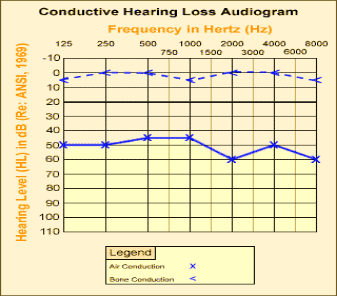
CONDUCTIVE HEARING LOSS
Definition: This type of hearing loss can occur due to any condition which interferes with the conduction of sound reaching the cochlea.
The lesion may lie in the external ear, tympanic membrane, middle ear or ossicles up to stapediovestibular joint (oval window).

Aetiology:
The conductive hearing loss may be congenital or acquired.
Congenital
- Atresia of the external canal.
- Congenital cholesteatoma.
- Stapes fixation.
- Malleus head fixation.
Acquired
- External ear
- Wax.
- Foreign body.
- Furuncle.
- Acute inflammation.
- Exostosis of ear canal.
- Middle ear
- Tympanic membrane perforation.
- Conditions having fluid in the middle ear, Hemotympanum, Acute otitis media, Secretory otitis media.
- Ossicular fixation.
- Eustachian tube blockage.
- Tumors of middle ear.

Clinical assessment of hearing loss:
- Tuning fork tests
- Weber test: It is done with 512 Hz tuning fork. The sound lateralizes to the worse affected ear in pure conductive hearing loss.
- Absolute bone conduction test: This test is done to differentiate between conductive and sensorineural hearing loss. It is normal in conductive hearing loss.
-
- It is a qualitative and quantitative analysis of patients hearing.
- It is helpful for medico legal purposes.
- Helps in evaluating the pre and post-operative result.
- Useful in malingering

3. Impedance audiometry: Useful in intact tympanic membrane to know the cause of conductive hearing loss.
4. Impedance audiometry: Useful in intact tympanic membrane to know the cause of conductive hearing loss.
Management: Most cases of conductive hearing loss can be managed by medical or surgical means.
Common surgical procedures include
- Removal of canal obstruction (wax, foreign body).
- Removal of fluid by myringotomy.
- Tympanoplasty for perforation of eardrum or ossicular pathologies.
- Stapedotomy for otosclerosis.
- Mastoidectomy for cholesteatoma.
- Facial nerve surgeries for facial nerve abnormalities.
- Hearing aid for surgically unfit patients.
We Are Always Ready to Help You.
Book An Appointment

